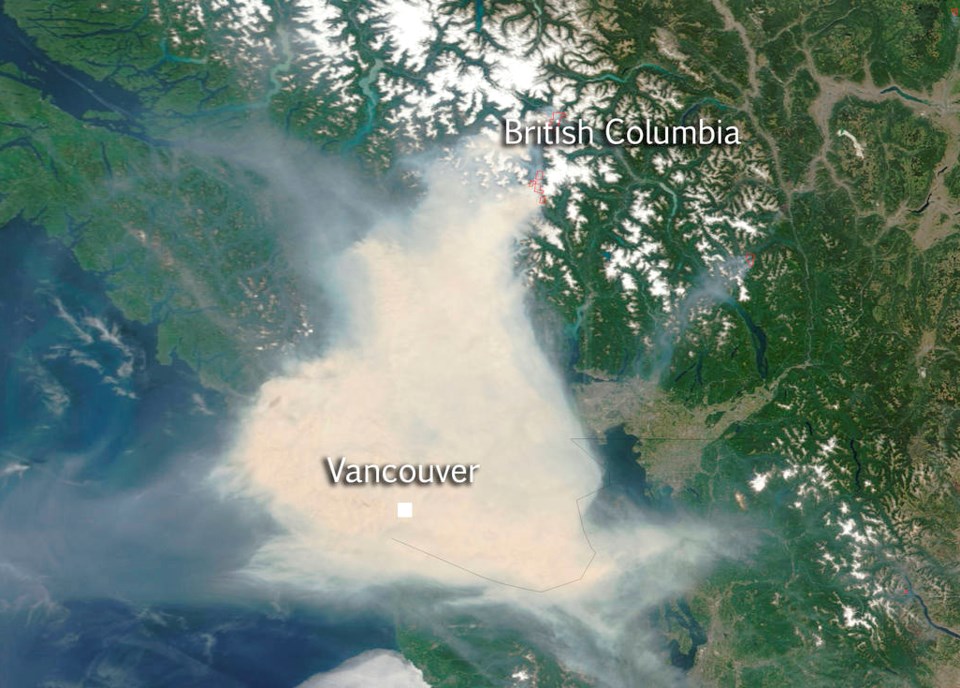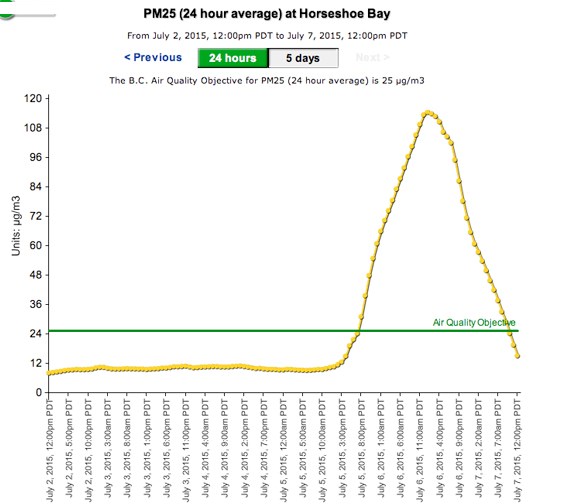Air quality on the North Shore is expected to improve slightly over the next few days although an air quality advisory remains in effect over smoke from nearby forest fires.
Residents awoke Sunday to find local landmarks obscured by a haze of smoke from forest fires while the sun glowed an eerie orange. Metro Vancouver issued an air quality advisory warning those with respiratory problems to be cautious after levels of fine particular matter from the smoke reached four times usually acceptable levels throughout much of the Lower Mainland.
“These are amongst the worst conditions that I remember,” said Julie Saxton, air quality planner with Metro Vancouver.

The air quality advisory focused on fine particulate matter, which is a special concern, because it is easily breathed in to the respiratory system. “The very fine particles can get deep into the lungs,” said Saxton.
Metro Vancouver usually flags anything over 25 micrograms of particulate per cubic metre of air as a potential problem.
By midday Monday, air quality monitoring stations in Mahon Park and Horseshoe Bay were measuring some of the highest readings in the Lower Mainland — at over 100 micrograms per cubic metre.
By Monday evening, however, those readings had fallen again to under 25 micrograms, and by Tuesday morning, North Shore stations were measuring fewer than 10 micrograms.
Residents in Squamish and Whistler weren’t so lucky. By Tuesday, smoke and shifting winds there resulted in fine particulate readings that were rated a very high health risk.
Dr. Mark Lysyshyn, medical health officer for the North Shore region, said fine particulates from the smoke are mainly a health concern for people with pre-existing respiratory conditions, like asthma — as well as for infants, whose lungs are still developing. Elderly people with chronic health conditions and anyone with cardiovascular problems that inhibit the body’s ability to absorb oxygen can also be adversely affected by the smoke.
Lysyshyn said anecdotal reports from doctors working in Lions Gate Hospital’s emergency department haven’t indicated any more people than would usually be expected coming in with respiratory problems. Lysyshyn said his office did get some calls from daycares on Monday, wondering if kids should be taking part in outdoors activities. His advice was to err on the side of caution and make it an “inside” day.
Those with health concerns were told Sunday and Monday to spend as much time as possible inside an air-conditioned building.
Some people were observed sporting protective face masks out in public Monday.
Since many residences on the North Shore don’t have air conditioning, a lot of people had to choose Sunday night between sleeping in stifling heat or breathing smoky air.
Several nearby forest fires have contributed to the smoke, including a fire in the Elaho Valley where an estimated 20,000 hectares were burning and another at Boulder Creek where 5,000 hectares were burning — both caused by lightning west of Pemberton.
“They are probably the two biggest smoke producers,” said Chris Gibbons, Environment Canada meteorologist.

Smoke from a 250-hectare forest fire burning near West Sechelt on the Sunshine Coast — believed to be human-caused — has also contributed to the smoke.
All of those fires grew over the weekend.
Gibbons said cooler marine air being pushed into the coast from the Pacific should help dissipate some of the smoke over the next few days. Another weather system moving in from the Pacific at the end of this week should also help.
One thing that isn’t forecast anytime soon is rain, as a high-pressure pattern continues over the south coast. That’s not unusual for this time of year, said Gibbons. “We’re already into July.”
Climate forecasters who examine long-range weather patterns have predicted this summer on the West Coast will be hotter and drier than normal.



